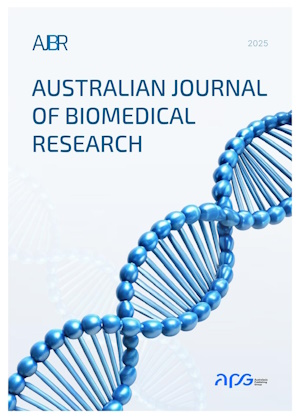
About Journal
The Australian Journal of Biomedical Research (ISSN: 3083-4708) is an international, peer-reviewed, open-access journal dedicated to publishing high-quality research in all areas of biomedical sciences. Published quarterly by the Australasia Publishing Group, AJBR fosters the dissemination of scientific knowledge across the Asia-Pacific region and globally.
Focus Areas Include: Molecular and Cellular Biology; Clinical and Translational Research; Pharmacology and Toxicology; Biomedical Engineering; Genomics and Proteomics; Infectious and Non-Communicable Diseases; Regenerative Medicine and Stem Cell Research
Frequency: Quarterly
Article Types: Original Research, Reviews, Case Reports, Short Communications, Editorials
CURRENT ISSUE
Volume 1, Issue 2, 2025
(Ongoing)
Aim: This review examines the relationship between diet and cancer in Nigeria, focusing on the current cancer burden of Nigeria, carcinogenic risks linked to food preparation, and preventive nutritional strategies.
Methods: Information was sourced from PubMed, Scopus, Google Scholar, and ResearchGate, alongside reports from global health agencies. Search terms included “diet,” “cancer,” “Nigeria,” “food,” “carcinogens,” and “prevention.” Only articles written in English language and that met predefined inclusion criteria were included.
Results: Evidence suggests that the consumption of carcinogens formed through traditional cooking methods increases the risk of cancer. Notable concerns include barbecue-style cooking, repeated use of cooking oils, and heavy metal contamination in local alcoholic beverages. Protective effects were observed in diets rich in fruits and vegetables.
Conclusion: Dietary practices in Nigeria significantly shape cancer risk. Targeted interventions promoting nutrition education, protective food intake, and safer cooking methods are essential to reduce carcinogen exposure and lower the national cancer burden.
Methods: We reviewed emerging small-molecule modalities—molecular glues, covalent inhibitors, and radiotheranostics—focusing on their mechanisms, clinical applications, and translational challenges. Key clinical trials and representative examples were identified from recent oncology literature.
Results: Molecular glues enable targeted degradation of previously undruggable proteins, with clinical success in multiple myeloma (IMiDs). Covalent inhibitors achieve durable suppression of oncogenic drivers such as KRAS^G12C and BTK, as shown in CodeBreaK100 (sotorasib; N=126; ORR 37%). Radiotheranostics combine imaging and therapy, exemplified by VISION (PSMA-617; N=831; OS HR 0.62) and NETTER-1 (Lutathera; N=229; PFS HR 0.21). Collectively, these modalities expand the druggable proteome, improve durability, and advance precision oncology.
Conclusion: Emerging small-molecule approaches mark a paradigm shift from inhibition alone to targeted degradation, durable covalent engagement, and diagnostic–therapeutic hybrids. Future priorities include improving selectivity, biomarker integration, scalable manufacturing, and equitable global access.
Objective: This study investigated the cardioprotective potential of beetroot fruit powder (BFP) against MSG-induced cardiotoxicity in male Wistar rats by evaluating its effects on inflammatory, oxidative, apoptotic, cardiac functional markers, and DNA fragmentation index.
Methods: Fifty male Wistar rats (185–205 g) were randomly divided into five groups: control, MSG-only, MSG + low-dose BFP (0.18 g/kg), MSG + high-dose BFP (0.36 g/kg), and MSG recovery group. MSG was administered orally (6 g/kg) for 21 days. BFP treatments were co-administered with MSG. On day 22, cardiac tissues were harvested and analyzed for inflammatory markers (MPO, NO, CRP, TNF-α, IL-1β, NF-κB), oxidative stress markers (MDA, SOD, CAT, GSH, GPx, GST), cardiac enzymes (LDH, SDH, CK, GGT), caspase-3 activity, and DNA fragmentation (TUNEL assay). Histological examination was also performed.
Results: MSG exposure significantly elevated pro-inflammatory cytokines, oxidative stress, caspase-3 activity, and cardiac dysfunction markers, alongside pronounced DNA fragmentation and histological alterations. BFP co-treatment, particularly at the high dose, significantly attenuated these changes by reducing pro-inflammatory markers, restoring antioxidant enzyme levels, normalizing cardiac enzyme activities, and lowering DNA fragmentation index. Histology confirmed structural recovery of cardiac tissue in BFP-treated groups. These results underscore the potential of BFP as a dietary intervention to mitigate chemically induced myocardial injury. While the MSG dose used exceeds typical human exposure, this model provides valuable mechanistic insights. Future studies should explore chronic, lower-dose MSG exposure, gene-level regulatory mechanisms, and translational trials in humans.
Conclusion: Beetroot fruit powder demonstrates a potent cardioprotective effect against MSG-induced toxicity by modulating oxidative, inflammatory, apoptotic, and functional biomarkers. These findings highlight its potential as a natural therapeutic agent for mitigating chemically-induced cardiac injury.


